ADDRESS AT THE 92ND INDIAN SCIENCE CONGRESS, AHMEDABAD
05-01-2005 : Ahmedabad
What can be the mission for the Scientists?
Friends, since this Science Congress focuses health technology as fulcrum of development, I am starting with thoughts on Pharma and healthcare.
In the year 2004, I have visited five R&D laboratories of Pharma Industries and three health centres and also I have addressed seven medical conferences on Ophthalmology, Cardiology, Liver diseases, allergic diseases, Vascular surgery, general surgery, atherosclerosis and thrombosis and Pharma vision 2020. I was very happy to see the economic strength of the Pharma industry resulting from the technological innovation of their R&D laboratories. In the year 2000 there was a fear among the members of the health sector and scientists that they will not be able to compete in the international market due to WTO environment. When I now visited these Pharma units, I find the situation is totally changed. The confidence of the Pharma community is coming in a big way due to the establishment of state-of-the-art R&D labs. During my visit I discussed with the scientists, technologists and I am completely convinced that Indian Pharma sector is becoming very robust with a sound research and development base. Even though they have developed hundreds of molecules, the way the scientific and laboratory experiments are progressing, I am convinced that at least three major molecules will transform into drugs very soon.
Now I would like to give my visualization of developed India in 2020 and the mission of scientific community.
Developed India in 2020
1. A Nation where the rural and urban divide has reduced to a thin line.
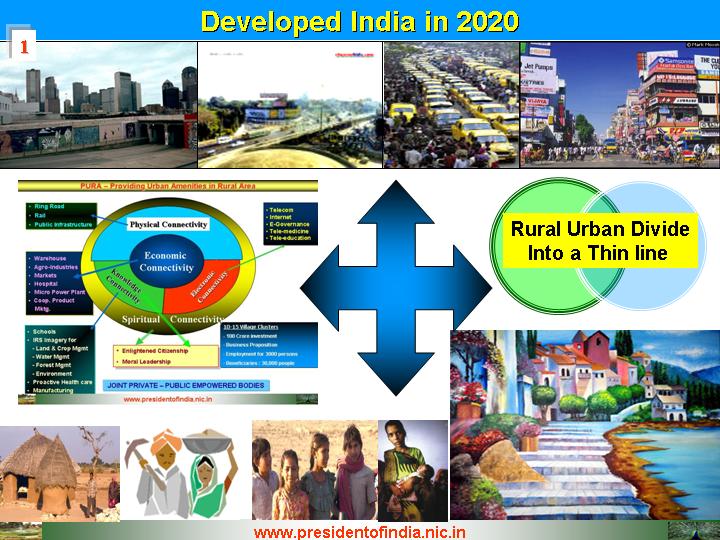
2. A Nation where there is an equitable distribution of energy, quality water and access to quality electric power.
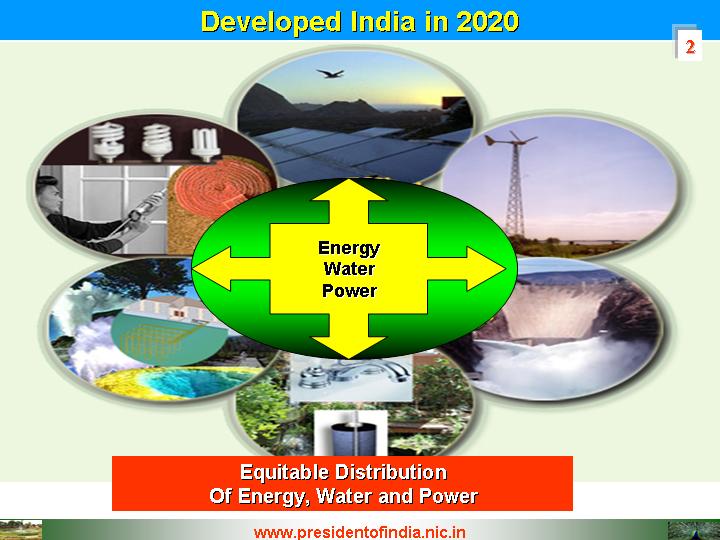
3. A Nation where agriculture, industry and service sector work together in symphony, absorbing technology thereby resulting in sustained wealth generation leading to higher employment potential.
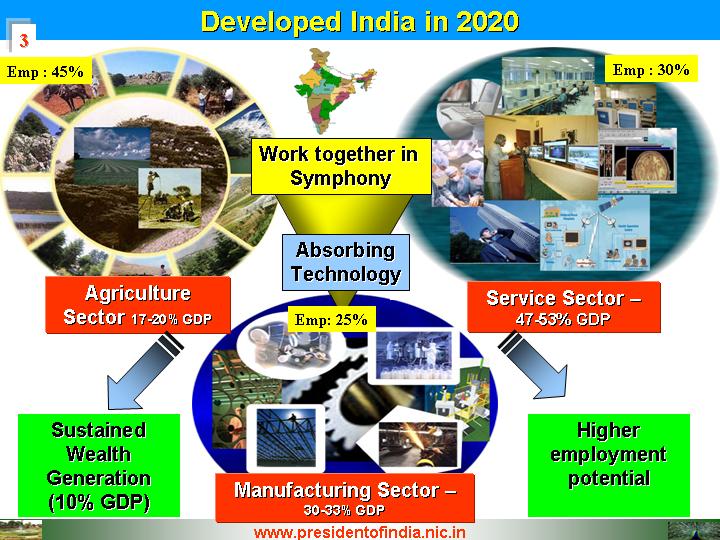
4. A Nation where education is not denied to any meritorious candidates because of societal or economic discrimination.
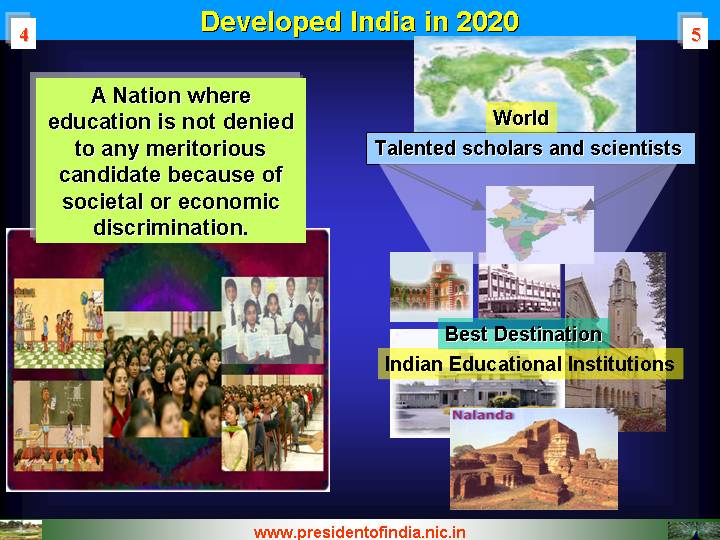
5. A Nation which is the best destination for the most talented scholars and scientists all over the world.
6. A Nation where the best of health care is available to all the billion population and the communicable diseases like AIDS/TB, water and vector borne diseases, Cardiac diseases and Cancer are extinct.
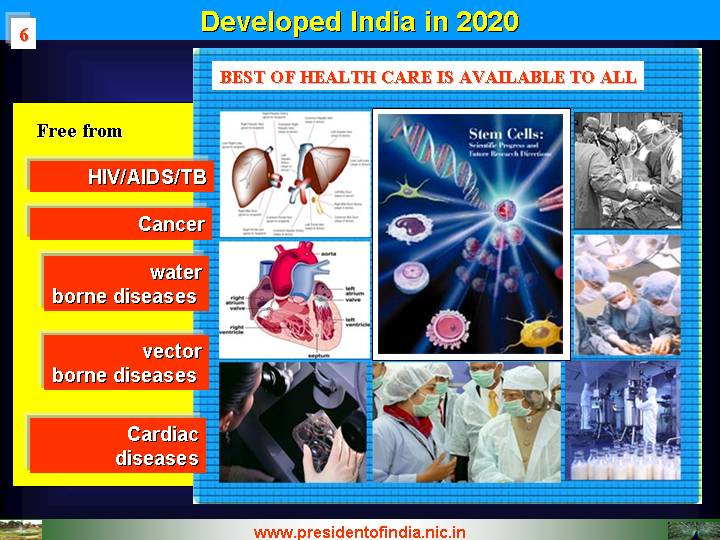
7. A Nation where the governance uses the best of the technologies to be responsive, transparent, easily accessible and simple in rules, thereby corruption free.
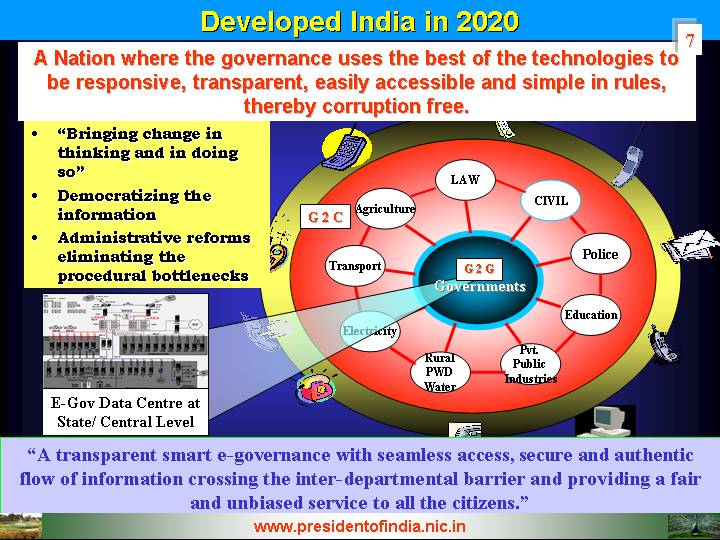
8. A Nation where poverty has been totally alleviated, illiteracy and crime against women are eradicated and the society is unalienated.
9. A Nation that is prosperous, healthy, secure, peaceful and happy.
10. A Nation that is one of the best places to live in, on the earth and brings smiles on a billion plus faces.
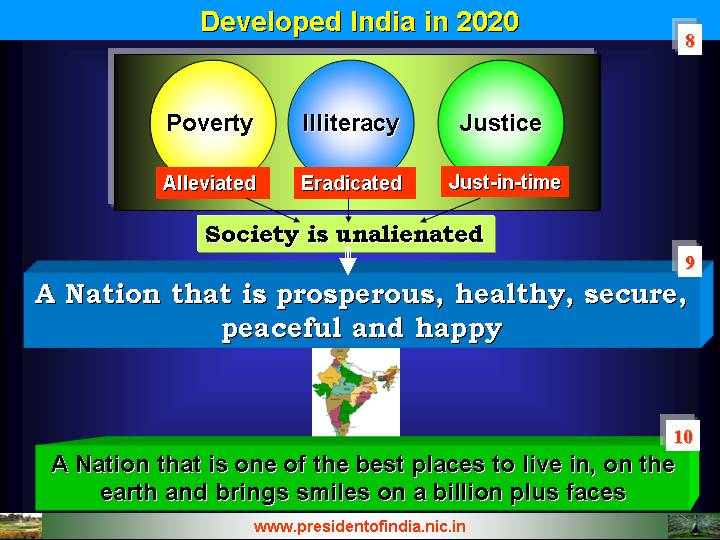
These are the ten dimensional transformations needed for competitive India and we have to work for it. Towards this end I would like to share thoughts on expected important achievements in Science and Technology in 2005.


2005 Science progress
I have visited number of science and technology laboratories and also had the opportunity to interact with the scientific and technological communities. My assessment is: five important S&T areas will influence Indian society in healthcare, education, employment generation and defence during 2005.
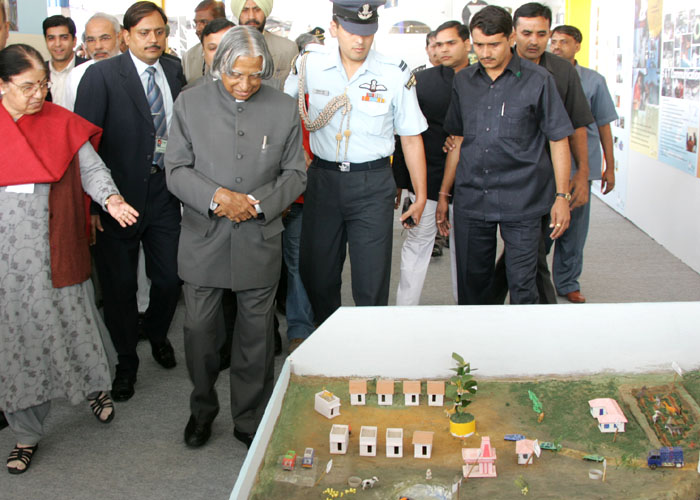

Stem cell research
Many Indian laboratories and hospitals are working in Research and Development of Stem Cell growth. Advancement in Stem cell research in the country has brought confidence among expert doctors to take up its clinical application in heart, eye, pancreas, liver, neural, kidney diseases and spinal injury. Drawing of tens of thousands of stem cells, which are capable of transforming themselves into almost any kind of tissues from the suffering patients and injecting them into the heart to stimulate heart restoration has already been practiced. This increases the pumping efficiency from 25% to 40% over a period of four months. The recent identification and characterization of progenitors with stem cell properties has opened new avenues that will be useful for treating functional impairments caused by the death of specific cell population in the eye region. The stem cells also help restoration of vision in patients who have these diseases, by repopulating the damaged ocular surface cells or retinal cells from further degeneration. Many healthcare institutions in India are working in Stem Cell area and have successfully treated heart patients and eye patients. Recently a patient with spinal cord injuries has been successfully treated with stem cells from umbilical cord blood in South Korea and it could signal a leap forward in the treatment of spinal cord injuries. Definitely we will see wide spread stem cell research and its application to treatment of many diseases in a cost effective way.
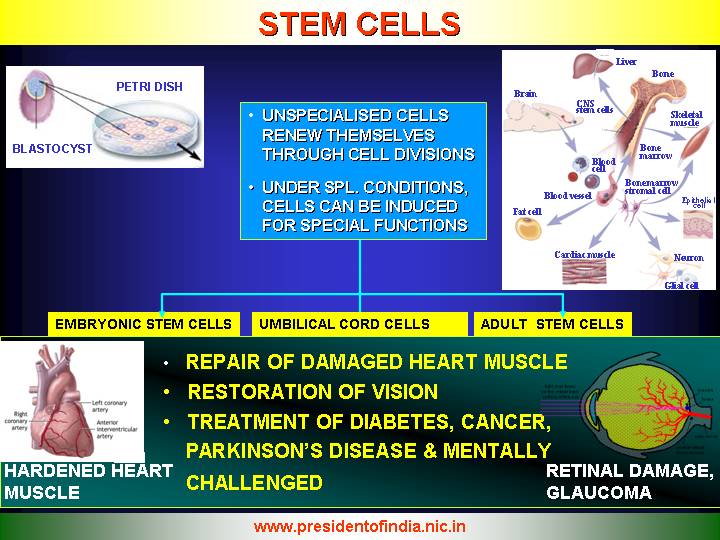

Interactive Tele-education delivery system
Availability of quality education for remote areas requires tele-education as a vital tool. ISRO?s EDUSAT (Educational Satellite) programme is designed to provide support to education through low-cost ground segments and to reach the un-reached people of India. The satellite is specially configured to have multiple beams covering different regions of India, through five regional beams and a national beam.
This system will be useful for school, college higher level of education; and non-formal education. The EDUSAT, when fully operational will have a capacity of 30 uplinks and about 5000 remote terminals per uplink. EDUSAT is expected to provide one-lakh fifty thousand ground terminals in its full capacity. EDUSAT is not only a Receive Only Terminal system; it works on an IP protocol and brings both way interactivity and collaboration. EDUSAT coupled with the Broadband through Fiber, wireless broadband will form a heterogeneous network in taking the quality education to all parts of the country. For example, a mathematics teacher takes a class at Bhimavaram, Andhra Pradesh, it is beamed to EDUSAT satellite in real time and the students in the class rooms at Samastipur in Bihar will see the teacher and hear the lessons. Hence a good teacher teaching anywhere in the country in any language can be heard, seen and interacted with through the implementation of interactive tele-education delivery system over the EDUSAT, broadband and Wireless communication channels.
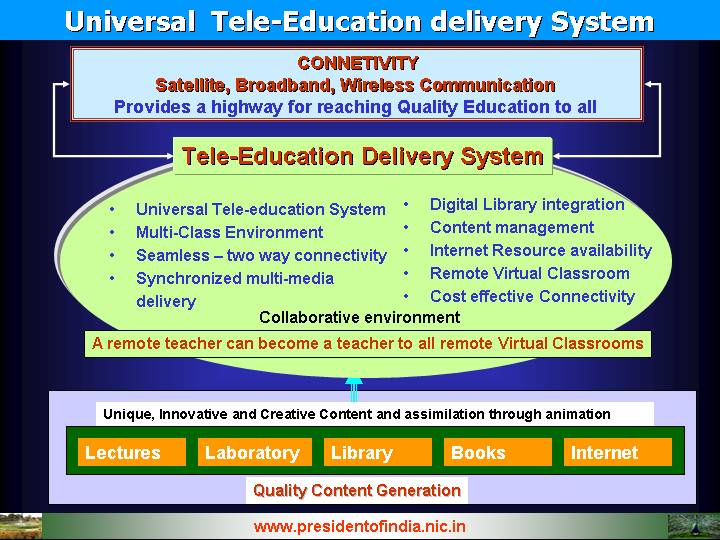

Bio-fuel - Jatropha
Use of Bio-fuel will increase many fold. Bio-fuel plant farming, harvesting, extraction and esterification process will provide large employment opportunities apart from bringing down the import of crude oil. Jatropha curcas is one of the bio-fuel plant and it can grow well in dry land with very little water input. Once grown the crop has fifty years of life. Fruiting can take place in this plant from six months to three years. It yields up to five tonnes per hectares of oil seeds which can produce two tones of bio-diesel. Bio-diesel plants grown in eleven million hectares of land can yield a revenue of approximately Rs.20,000 crore a year and provide employment to over eleven million people both for plantation, running of the extraction plants and trans-esterification. Use of Bio-diesel is Carbon mono-oxide emission free. This oil can also be used for soap and candle industries. It gives the by-product called Glycerin, which is used in Pharma industry. De-oiled cake is a raw material for composting and plantation is good for honey production. Jatropha saplings can be multiplied through Tissue culture and further research is required on hybrid varieties for increasing the oil content of seeds and drought resistant characteristics of the plant. Presently, the indigenously designed bio-fuel plant for 250 ltr/day is in operation. We have to design and develop bio-fuel plants of 3 to 10 tonnes per day capacity for installation in different parts of the country. Effective marketing chain need to be planned for enabling farmers to reap the benefits directly. Bio-fuel mission will provide technological and employment generation focuses for the rural sector. Use of eleven million hectares of waste land for Jetropha cultivation can lead to generation of minimum twelve million jobs.
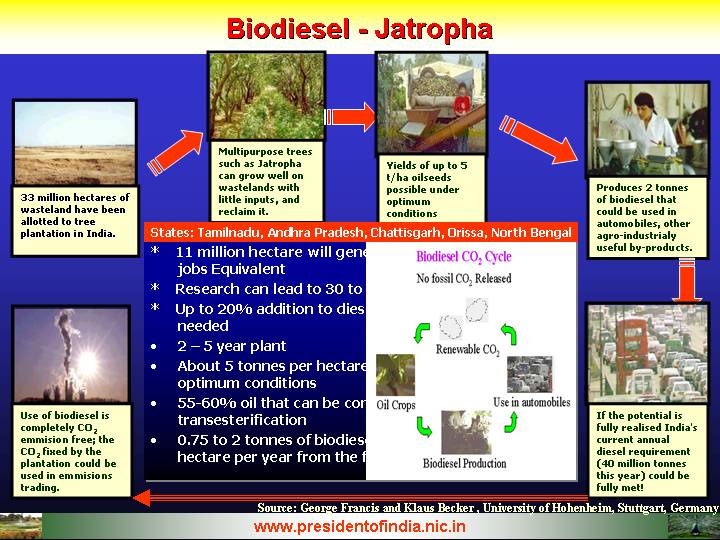

Brahmos: Supersonic cruise missile
The Indo-Russian joint venture has developed the supersonic cruise missile, the first of its kind in the world scene. It is a remarkable achievement for both countries. It is a force multiplier for defence forces. It is a universal missile flying at the speed of Mach 3 for multiplatform configuration by variety of trajectories against multiple targets. It is an opportunity for India and Russia to go in a big way to produce competitively and market the Brahmos to suitable countries.
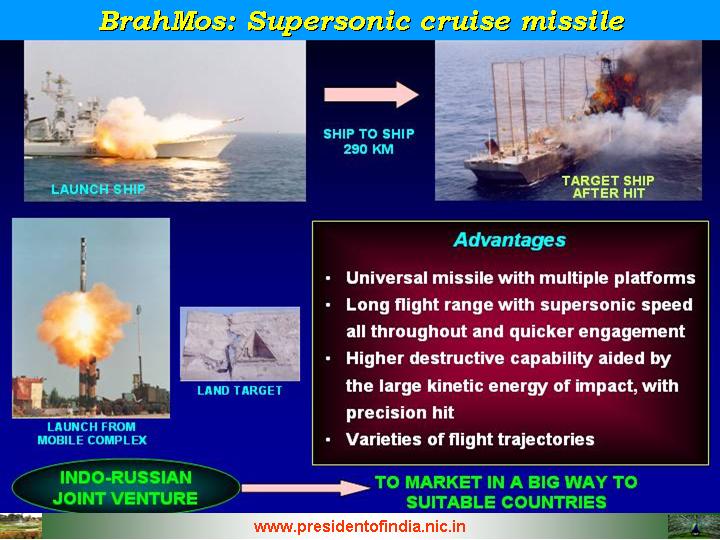

Molecules to drug
This year I have visited number of Pharma R&D Centres. There is a great movement in transforming molecules to drug, I feel in 2005, at least three drugs will materialize leading to the treatment of certain type of cancer and the other for diabetes and inflammatory diseases.
In addition to the above scientists have to take note of the progress made in Nano-Science and Nano-technology and participate in research and product development to make India a leading player and become an exporter of nano-technology products
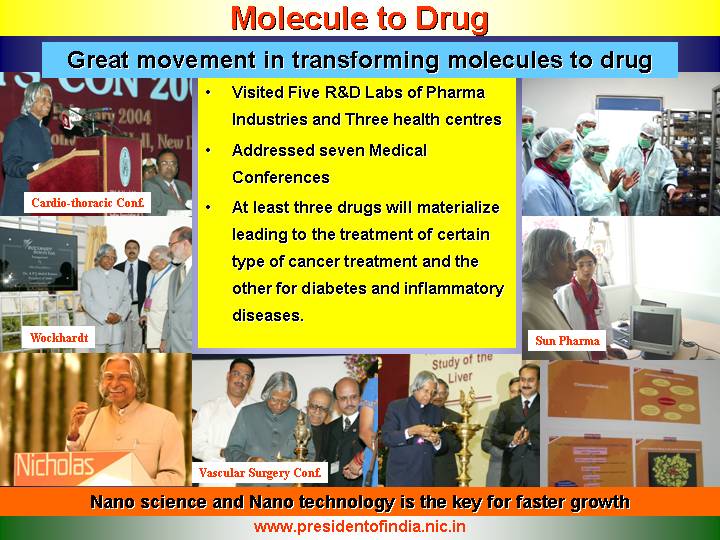

Technology through Ages
Through out the last 120 centuries, unique cultures have come into existence due to advancement in technology. The first 118 centuries had a dominance of primarily stone, bronze & iron ages. The last two centuries have seen rapid development of chemical age. The advancements made in material science and technology gave the impetus for both nuclear and biological age to flourish. Succession of these technology periods has involved progression from simpler materials to more complex forms of science and engineering. We are today at the convergence of Nano, Bio and Information technologies. This age, I feel will create historical revolution and we must be at driver?s seat to contribute towards this societal change.
When I think of Nano-science and Nano-technology, I am reminded of two personalities. First person is Richard Feynman, who described the concept of 'building machines" atom by atom in his talk at Caltech titled "There is plenty of room at the bottom". The second person is Eric Drexler, who wrote the book titled 'Nano Systems, Molecular machinery, manufacturing and computation".
Since independence, the country had all along been taking recourse to technology for societal changes and economic prosperity. A nation that is alert should be sensitive to the changes that take place to the technological fabric of the world and prepare itself for the arrival of newer changes in the horizon.
We believe that nano-technology would give us an opportunity, if we take an appropriate and timely action, we can become one of the important technological nations in the world.
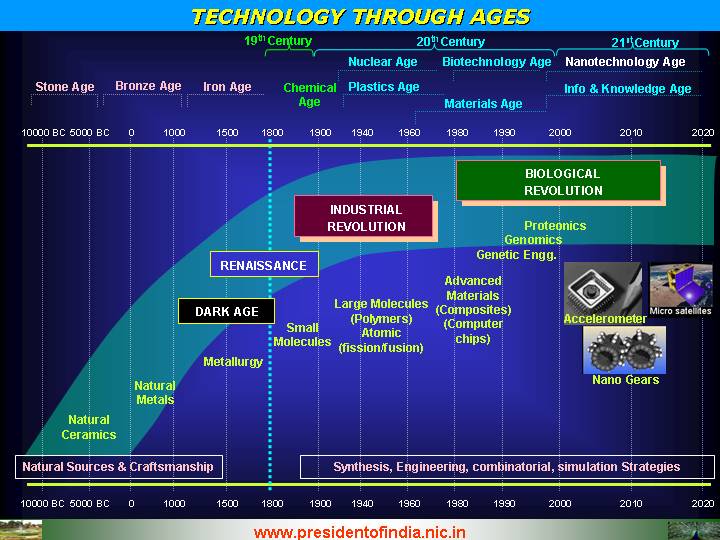

Applications
The world market in 2004 is for nano materials, nano tools, nano devices and nano biotechnology put together is over hundred billion dollars. It has been noticed that the fastest growing area among these is nano-biotechnology.
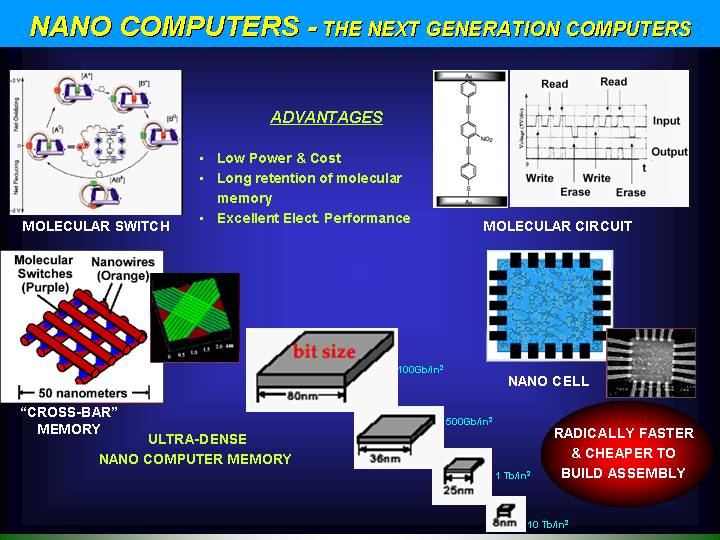
Carbon nano tubes and its composites will give rise to super strong, smart and intelligent structures in the field of material science. Nano-Biomedical sensors will play a major role in glucose detection and endoscopic implants. Drug delivery system will revolutionize the health-care to a large extent.
Molecular switches and circuits along with nano cell will pave the way for the next generation computers. Ultra dense computer memory coupled with excellent electrical performance will give the society low power, low cost, nano size and yet faster assemblies.
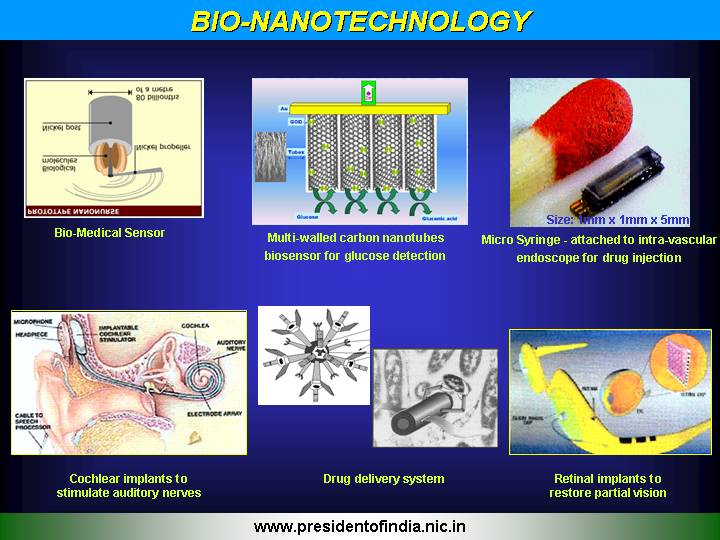
The last four decades have also affected the packaging concept. Electronics packaging of the past has given way to the present Microsystems packaging and the shift in the trend is now towards the futuristic nano packaging.
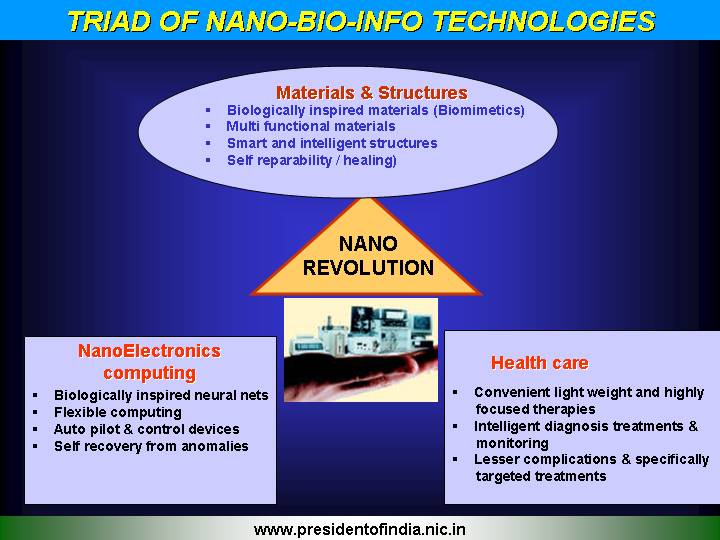

Treatment of Parkinson?s disease
Recently I met Prof. Vijay K Varadan of Pennsylvania State University, US. He shared his experience on the possible line of treatment for Parkinson?s disease and Epilepsy. The primary symptoms in Parkinson Disease as you all aware are tremor or trembling in hands, arms, legs, jaw, and face, rigidity or stiffness of the limbs, slowness of movement and impaired balance. Prof Varadan has devised a wireless system for monitoring and control of Parkinson?s disease. The system consists of an implantable DNA insert in the head region for generating a pulse to the nerve system; controlled either by a modified pacemaker or smart hat. A Passive polymer based gyro sensor, which is implanted in the tremor location. The sensor gets the power from the Pacemaker and the Pacemaker then reads the tremor motion. The Pacemaker then generates the pulse in the implanted device in the head to control the tremor. This appears to be a promising line of treatment for such diseases. Prof. Varadan also has reported that the few patients affected by Parkinson diseases had a full recovery.
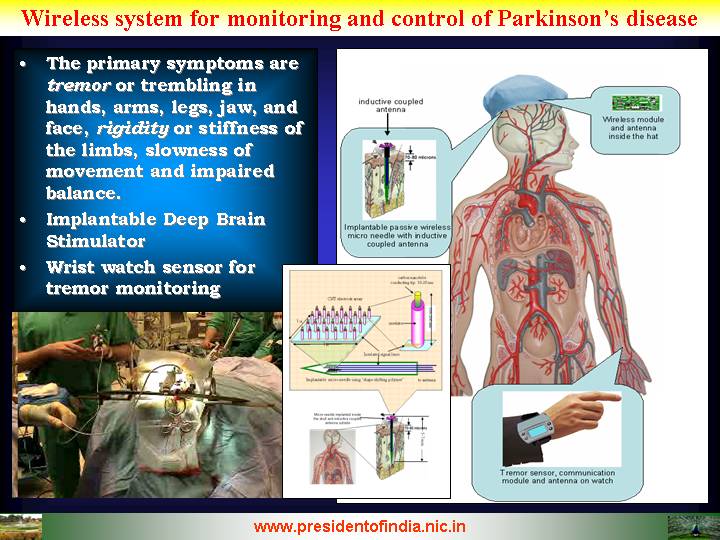

Solar Energy
CNT (Carbon Nano Tubes) based Photo-voltaic Cell: Presently silicon based photo-voltaic cell have only an efficiency of 13 to 15%. This has become a big challenge for converting solar energy into power. Research has shown promise of increasing the efficiency of the photo-voltaic cell to 40 to 50% using CNT. This will enable us to have highly efficient 100 MW solar energy plants in different regions of the country which will have virtually zero recurring cost.
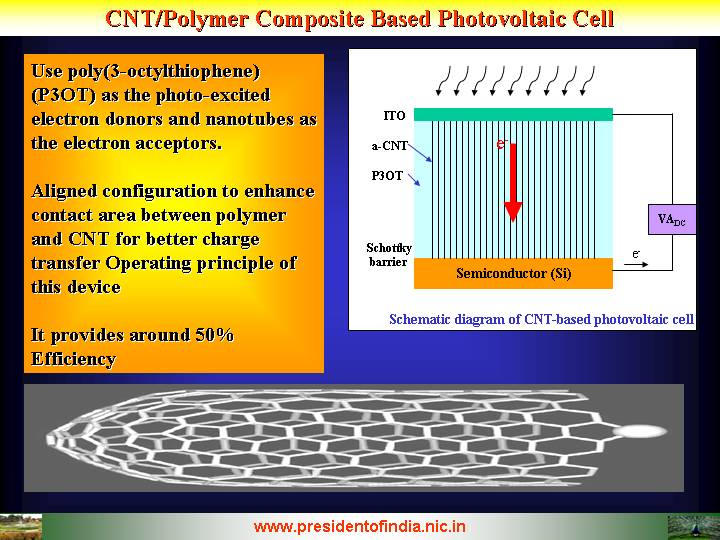

Shock embedded Tidal Wave (Tsunami)
As you are aware, the coastal region of our country faced a severe calamity due to shock embedded tidal wave, which will need an innovative package for reconstruction of homes of the affected population.
The scientists present here, have to ask yourself, what you can do in such a situation for bringing relief to the people and also what science can do to prevent such devastating occurrences in future. They can definitely contribute in the areas of prediction of earthquake on land and seabed.
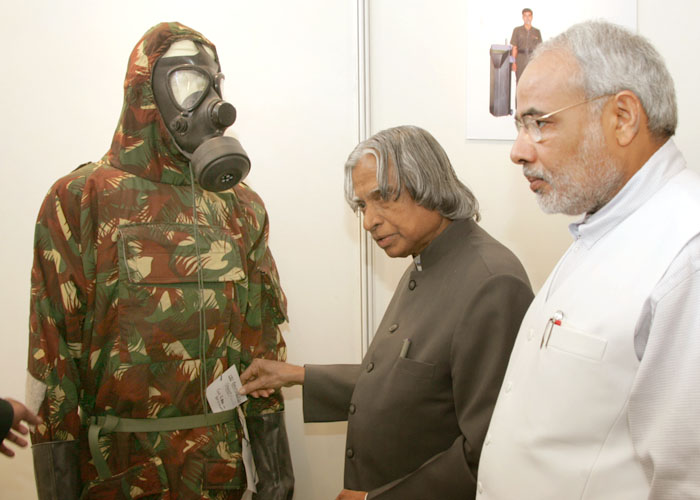

Prediction research
The Seismologists have put most of their efforts in studying seismic variations and patterns of foreshocks and aftershocks. In certain countries, earthquakes have been successfully predicted using a noticeable increase in background seismic activities. If foreshocks can be recognized early, giving a timely warning can save lives of many people. The stages of a rising seismic activity include, building up of elastic strain along a fault, development of cracks, increase in stress, decrease in electrical resistivity etc. This theoretical series of events could eventually lead to a way to predict the occurrence of major earthquakes. The events are still theoretical and need much more data to make them useful enough for practical applications.
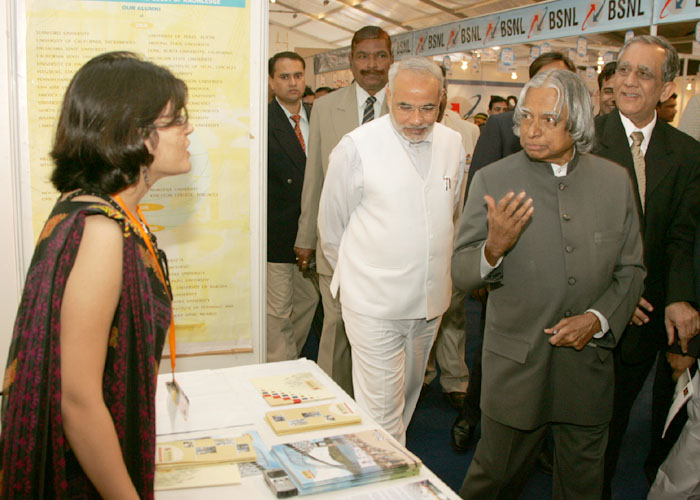

Science, Technology and Society
Technology is the non-linear tool available to humanity which can affect fundamental changes in the ground rules of economic competitiveness. Science is linked to technology through applications. Technology is linked to economy and environment through manufacture. Economy and environment linked to technology promotes prosperity to the society.
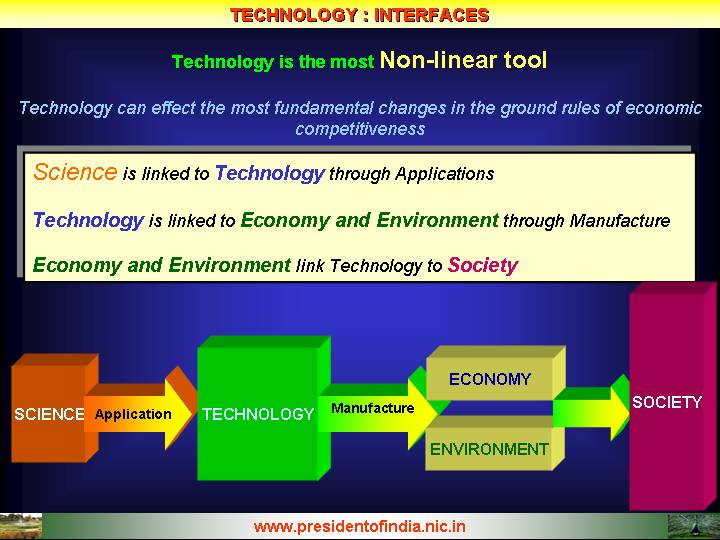
The scientists and technologists whatever work or mission they do always they have to ask the question, any part of my scientific work will it have a positive impact on meeting the human needs.
Now I would like to discuss about the challenges that the nation has to overcome and certain missions which are required to be implemented to transform India into a developed nation by the year 2020.
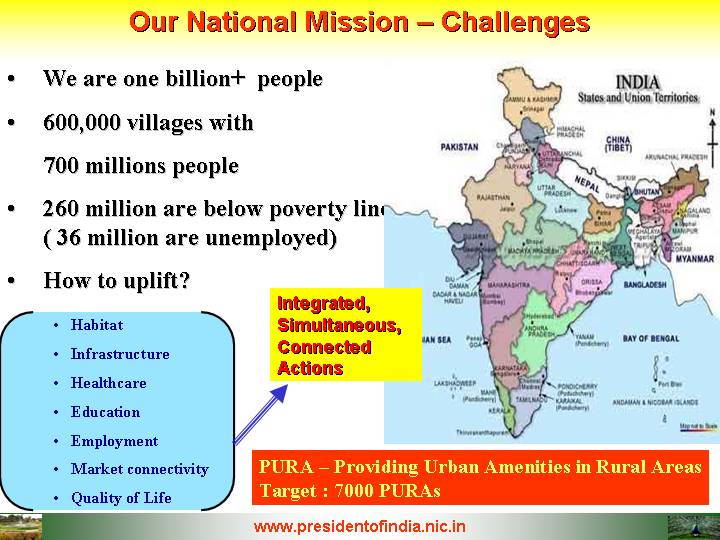
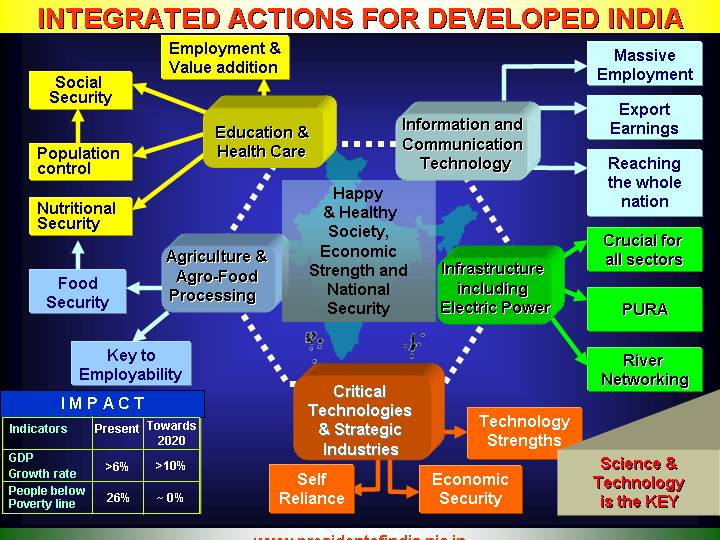
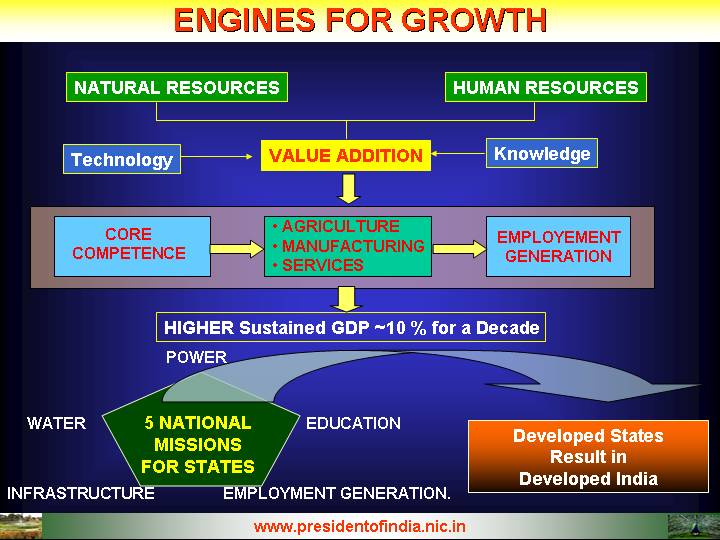

The Mission of PURA
The number of PURA units for the whole country is estimated to be 7000. This envisages integrated connectivities to bring prosperity to rural India. These are - physical connectivity of the village clusters through quality roads and transport; electronic connectivity through tele-communication with high bandwidth fiber optic cables reaching the rural areas from urban cities and through Internet kiosks; and knowledge connectivity through education, vocational training for farmers, artisans and craftsmen and entrepreneurship programmes. These three connectives will lead to economic connectivity through starting of enterprises with the help of banks, micro credits and marketing of the products.
Each PURA cluster will connect about 20 -30 villages depending upon the region and population and will cost about Rs.100 crores. This is a viable and sustainable business proposition. After initial short-term employment during construction etc., we have to plan for initiating actions for providing regular employment and self employment opportunities in nationally competitive small enterprises in agro processing, manufacturing and services sectors for about 3000 people. If the industrial/business parks are marketed well, they can generate employment opportunities in support and services sector for about 10000 people. This will provide sustainable economy for the rural sector. In this national mission, bankers can promote entrepreneurship in the rural areas. This will lead to the removal of urban-rural divide.
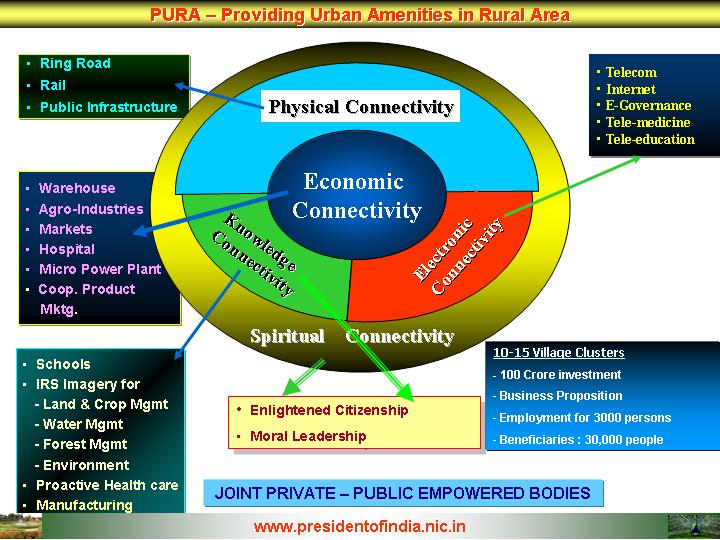

PURA as an Enterprise
A large number of banks have entrepreneurial development programmes. Banks have also been funding Small Scale Industries of different types in various regions. The small scale industrialist is a promising candidate for becoming the chief executive for managing the PURA complexes in an integrated way. PURA enterprises can also undertake management of schools, health care units, vocational training centres, chilling plants, silos and building a market, banking system and the regional business or industrial units. A new mission mode management style has to emerge for PURA enterprises. It should not be looking for protective legislations to support them. Rather they should be efficient to compete with others. This new PURA enterprise needs partnership from the bank, from the Government and also from the private entrepreneurs. Banks can train the entrepreneur for managing the PURA in their training centres and also provide them loans for creating and running PURAs as a business proposition.
I would like to talk to you the experiences of our three well known scientists.
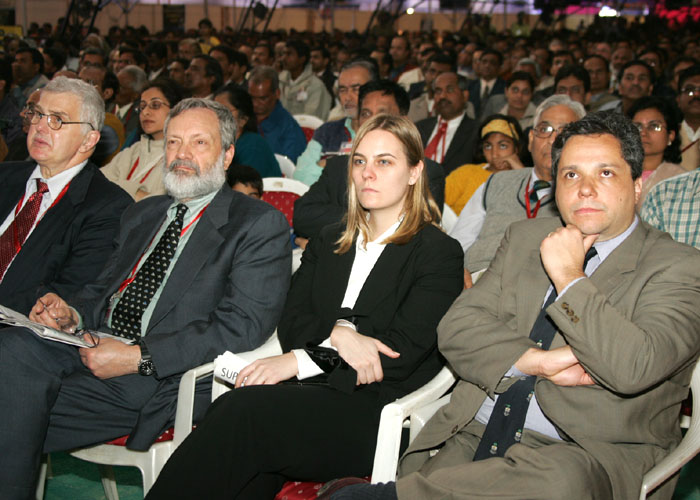

Dr. Kothari
Dr DS Kothari, a Professor in Delhi University was an outstanding Physicist and also an Astrophysicist. He is well known for ionization of matter by pressure in cold compact objects like planets. This theory is complementary to thermal ionization word done by Dr Meghnad Saha his guru. When he became the Scientific Adviser to Defence Minister he established the Defence Science Centre which became the nuclei for generation of products and systems required by the Armed Forces.
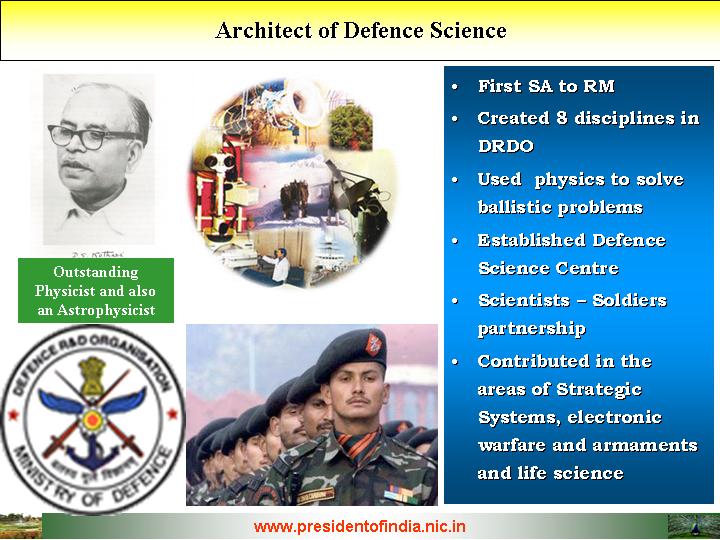

Dr. Homi Jehangir Bhabha
Homi Bhabha carried out research relating to cosmic radiation. In 1939, he joined Sir CV Raman in IISc Bangalore. Later, he was asked to start Tata Institute of Fundamental Research with focus on nuclear science, mathematical science and established Atomic Energy Commission in 1948. Multi centers were born as part of BARC with his vision in nuclear science to nuclear technology, nuclear power, nuclear devices and nuclear medicine.
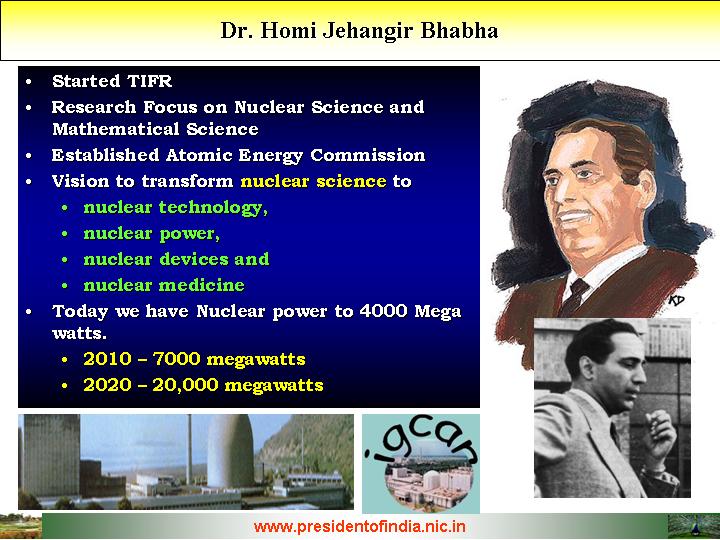

Prof. Vikram Sarabhai
Prof Vikram Sarabhai the youngest of the three and worked with Sri CV Raman in experimental cosmic ray. Prof Sarabhai established Physical Research Laboratory in Ahmedabad with Space research as focus. In later years he become the Director of Space S&T Centre. The SSTC (1963) started with launching sounding rockets for space atmospheric research. Prof. Vikram Sarabhai unfurled the space mission for India in 1970 that we should build Satellite Launch Vehicle capability, to put our communication satellites in the geo-synchronous orbit and remote sensing satellites in the polar orbit. Also, he envisaged that launch vehicles built in India should be launched from Indian soil. This one visionary thought led to intensive research in multiple fields of science and space technology. Many of us had the fortune to be part of Prof. Vikram Sarabhai's vision. Today, India has the capability to build any type of satellite and launch it from its soil.
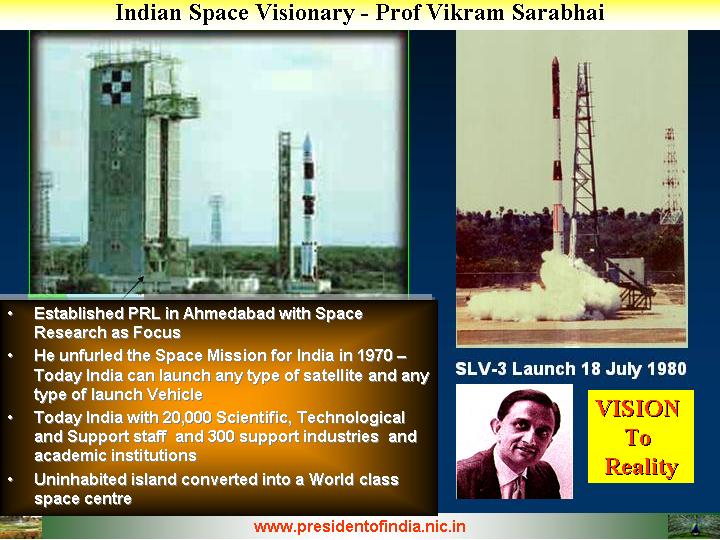

Conclusion
These three Indian scientists, all of them physicists, started physics research institutions that blossomed into defence technology, nuclear technology and space technology. When I study deep into their knowledge and the vision, I believe they would have realized that science has to be promoted through political systems. It is essential that technologies that give immediate benefits to the people directly or indirectly should be successfully put forward. The three great institutions have emerged with 20000 scientists spread in institutions all over the country. Another important message conveyed by these three great scientists is that basic science is very vital for growth of technology and growth of scientific and technological human resource and thereby transforming the society.
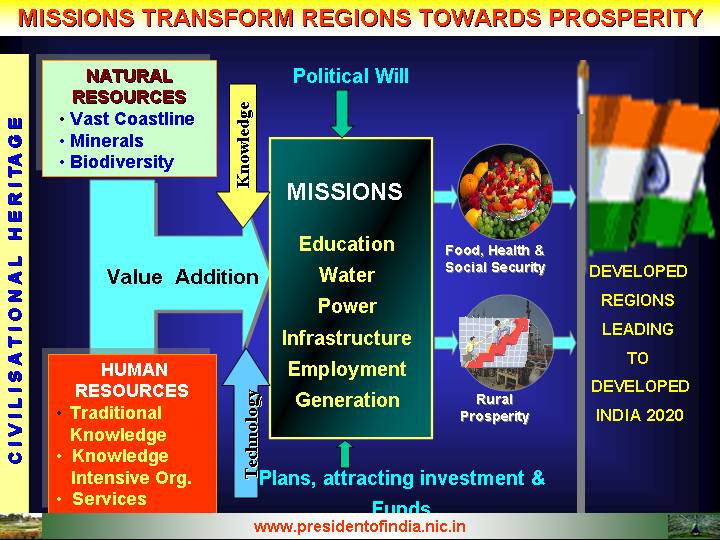
Particularly for young scientists who have assembled here, I am giving these role models, so that when you are doing scientific research you always ask yourself, ?Can my research and development task contribute to the upliftment of the people of my country?. It may be any area of research: medical science, physics, chemistry, space research, nuclear research, defence research, mathematical science, earth sciences etc. Particularly for developing country like ours which has a vision for a developed nation, your contribution in the scientific field is all the more important.
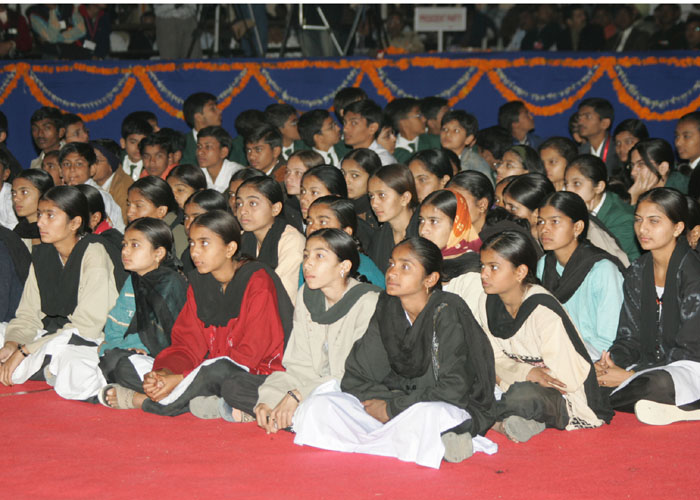
My New Year greetings and best wishes to all of you. May God bless you.
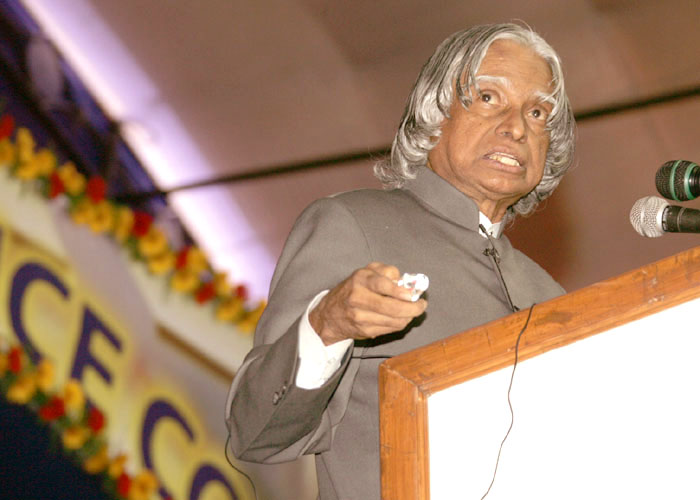
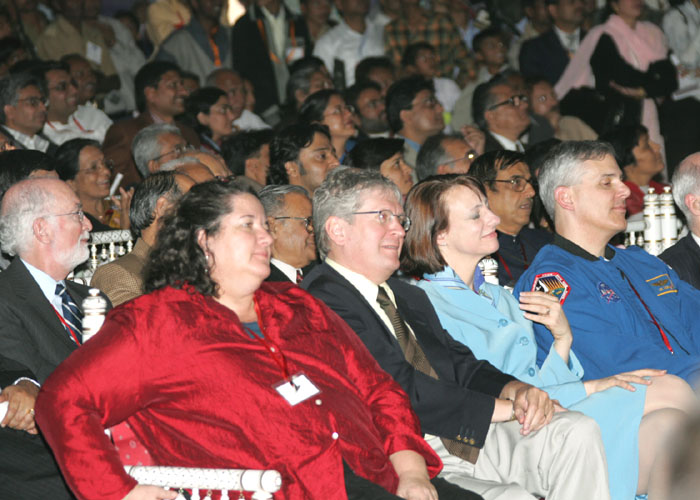
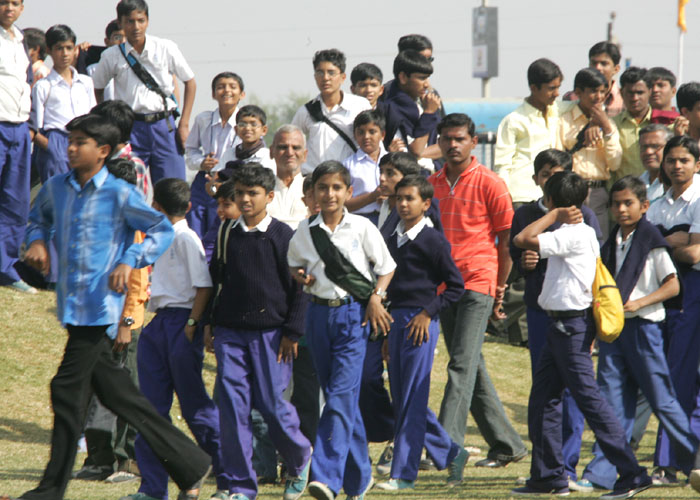
<<Back
|